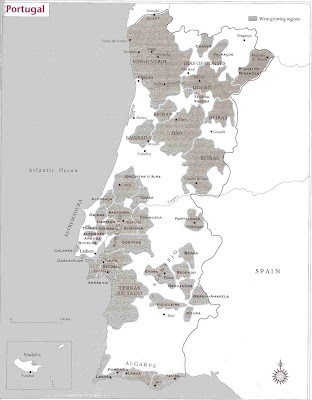
Sourced from
Winesfromspain.comAirén- This is Spain's most widely planted white grape variety. The bunches are large and tightly-packed. It produces wines with a characteristic bouquet and alcohol content between 12% vol. and 14% vol. It can be found, among other regions, in Ciudad Real (51% of planting), Toledo, Cuenca, Albacete, Murcia and Madrid. It is the main variety in Vinos de Madrid DO.
Albariño
White. Native to Galicia, with small, very sweet glyceric berries which produce high quality wines. It is the basic grape of Rías Baixas DO. There has been a dramatic increase in the area planted with this grape over the last few years.
Garnacha Blanca
White Garnacha. Produces full-bodied wines with a high alcohol content. Very abundant throughout Spain, especially in Tarragona, Zaragoza and Teruel. It is classified as a main variety in Alella, Costers del Segre, Tarragona and Terra Alta DOs.
Garnacha Tinta
Red Garnacha. A high-yielding grape that produces vigorous wines. This is the most widely grown red grape in Spain, especially in La Rioja, Madrid, Navarre, Tarragona, Teruel, Toledo and Zaragoza. It is considered a main variety in the following DOs: Ampurdán-Costa Brava, Calatayud, Campo de Borja, Cariñena, Costers del Segre, La Mancha, Méntrida, Penedés, Priorato, Somontano, Tarragona, Terra Alta, Utiel-Requena, Valdeorras and Vinos de Madrid.
Garnacha Tintorera
Red. This grape, also known as Alicante, is so-called because it is the only variety, along with Alicante Bouché, which has coloured flesh (tintorera comes from the verb teñir = to dye). It is widely planted in Albacete, Alicante, Orense and Pontevedra, and it is considered a main variety in Almansa DO.
Godello
White. A high quality, very aromatic grape. Native to Galicia, new planting has been encouraged in the last few years, especially in Valdeorras DO. It is considered a main variety in Valdeorras and Bierzo DOs.
Loureira
White high quality Galician grape that creates very aromatic wines. Authorised in Rías Baixas and Ribeiro DOs. There is also a red Loureira, but it is very rare.
Macabeo
White. Also called Viura. This is the basic cava variety. Mainly found in Badajoz, La Rioja, Tarragona and Zaragoza, this is considered a main variety in Calatayud, Conca de Barberá, Costers del Segre, Navarra, Penedés, Rioja, Somontano, Tarragona and Terra Alta DOs.
Mencía
Red. According to recent studies, this grape is very similar to Cabernet Franc. It produces high quality wines and is most widely planted in León (68%), Zamora, Lugo and Orense provinces. It is considered a main variety in Valdeorras and Bierzo DOs.
Moscatel
White, superbly aromatic grape with a high sugar content. It produces very characteristic wines and is also frequently consumed directly as a dessert grape. Widely grown across the whole of Spain, it is particularly frequent in Valencia and Málaga. It is also considered a main variety in Málaga and Valencia DOs.
Palomino
White. A basic grape in Jerez wines, called Jerez outside this growing area. Its high yields led to extensive planting in many Spanish regions, especially Galicia. It flourishes in Cádiz (68%), Orense, Valladolid, Zamora and Huelva. It is considered a main variety in Jerez and Condado de Huelva DOs.
Pedro Ximénez
White grape with a high sugar content. To a greater or lesser extent, it is found almost everywhere in Spain, It is most widespread in Córdoba (68%), Badajoz, Málaga and Valencia and is considered a main variety in the following DOs: Jerez, Málaga, Montilla-Moriles, and Valencia.
Tempranillo
Red. Superb quality and very aromatic, the star of Spanish grapes. It is called Ull de Llebre in Catalonia, Cencibel in Castile-La Mancha and Madrid, and Tinto Fino and Tinto del Pais in Castile and Leon. It flourishes in Burgos, La Rioja, Alava, Cuenca and Ciudad Real. It is considered a main variety in the following DOs: Calatayud, Cigales, Conca de Barbera, Costers del Segre, La Mancha, Penedes, Ribera del Duero, Rioja, Somontano, Utiel-Requena, Valdepenas, and Vinos de Madrid. Also known as Tinta del Pais, tinto fino
Tinta de Toro
Red. Produces aromatic, good quality wines, although it does not give high yields. Some maintain that it is an acclimatised version of Tempranillo that has become adapted to the region of Zamora, and that this is also the origin of its name. It is considered a main variety of Toro DO
Torrontés
White. Originally from Galicia, it produces wines of little body and good acidity, with considerable personality and an intense bouquet. It can be found throughout Galicia and in Córdoba.
Treixadura
White. Native to Galicia, this is one of the most aromatic varieties of Galician grape, and its cultivation is being encouraged in a number of areas. It is considered a main variety in Ribeiro DO.
Verdejo
White. Very high quality and one of the best white varieties in Spain. It makes very aromatic, glyceric, soft wines with body. It is plentiful in Valladolid (69%), Segovia and Ávila. It is considered a main variety of Rueda DO.
Xarel.lo o Xarello
White. Together with the Macabeo and Parellada varieties, it makes up the trilogy of cava grapes. It produces very aromatic wines. It is considered a main variety in the Alella (where it is known as Pansá), Costers del Segre, Penedés and Tarragona DOs, as well as in denominated cava-producing areas.

















